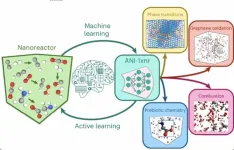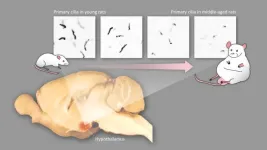(Press-News.org) Computers work in digits — 0s and 1s to be exact. Their calculations are digital; their processes are digital; even their memories are digital. All of which requires extraordinary power resources. As we look to the next evolution of computing and developing neuromorphic or “brain like” computing, those power requirements are unfeasible.
To advance neuromorphic computing, some researchers are looking at analog improvements. In other words, not just advancing software, but advancing hardware too. Research from the University of California San Diego and UC Riverside shows a promising new way to store and transmit information using disordered superconducting loops.
The team’s research, which appears in the Proceedings of the National Academy of Sciences, offers the ability of superconducting loops to demonstrate associative memory, which, in humans, allows the brain to remember the relationship between two unrelated items.
“I hope what we're designing, simulating and building will be able to do that kind of associative processing really fast,” stated UC San Diego Professor of Physics Robert C. Dynes, who is one of the paper’s co-authors.
Creating lasting memories
Picture it: you’re at a party and run into someone you haven’t seen in a while. You know their name but can’t quite recall it. Your brain starts to root around for the information: where did I meet this person? How were we introduced? If you’re lucky, your brain finds the pathway to retrieve what was missing. Sometimes, of course, you’re unlucky.
Dynes believes that short-term memory moves into long-term memory with repetition. In the case of a name, the more you see the person and use the name, the more deeply it is written into memory. This is why we still remember a song from when we were ten years old but can't remember what we had for lunch yesterday.
“Our brains have this remarkable gift of associative memory, which we don't really understand,” stated Dynes, who is also president emeritus of the University of California and former UC San Diego chancellor. “It can work through the probability of answers because it's so highly interconnected. This computer brain we built and modeled is also highly interactive. If you input a signal, the whole computer brain knows you did it.”
Staying in the loop
How do disordered superconducting loops work? You need a superconducting material — in this case, the team used yttrium barium copper oxide (YBCO). Known as a high-temperature superconductor, YBCO becomes superconducting around 90 Kelvin (-297 F), which in the world of physics, is not that cold. This made it relatively easy to modify. The YBCO thin films (about 10 microns wide) were manipulated with a combination of magnetic fields and currents to create a single flux quantum on the loop. When the current was removed, the flux quantum stayed in the loop. Think of this as a piece of information or memory.
This is one loop, but associative memory and processing require at least two pieces of information. For this, Dynes used disordered loops, meaning the loops are different sizes and follow different patterns — essentially random.
A Josephson juncture, or “weak link,” as it is sometimes known, in each loop acted as a gate through which the flux quanta could pass. This is how information is transferred and the associations are built.
Although traditional computing architecture has continuous high-energy requirements, not just for processing but also for memory storage, these superconducting loops show significant power savings — on the scale of a million times less. This is because the loops only require power when performing logic tasks. Memories are stored in the physical superconducting material and can remain there permanently, as long as the loop remains superconducting.
The number of memory locations available increases exponentially with more loops: one loop has three locations, but three loops have 27. For this research, the team built four loops with 81 locations. Next, Dynes would like to expand the number of loops and the number memory locations.
“We know these loops can store memories. We know the associative memory works. We just don’t know how stable it is with a higher number of loops,” he said.
This work is not only noteworthy to physicists and computer engineers; it may also be important to neuroscientists. Dynes talked to another University of California president emeritus, Richard Atkinson, a world-renowned cognitive scientist who helped create a seminal model of human memory called the Atkinson-Shiffrin model.
Atkinson, who is also former UC San Diego chancellor and professor emeritus in the School of Social Sciences, was excited about the possibilities he saw: “Bob and I have had some great discussions trying to determine if his physics-based neural network could be used to model the Atkinson-Shiffrin theory of memory. His system is quite different from other proposed physics-based neural networks, and is rich enough that it could be used to explain the workings of the brain’s memory system in terms of the underlying physical process. It’s a very exciting prospect.”
Full list of authors: Uday S. Goteti and Robert C. Dynes (both UC San Diego); Shane A. Cybart (UC Riverside).
This work was primarily supported as part of the Quantum Materials for Energy Efficient Neuromorphic Computing (Q-MEEN-C) (Department of Energy DE-SC0019273). Other support was provided by the Department of Energy National Nuclear Security Agency (DE-NA0004106) and the Air Force Office of Scientific Research (FA9550-20-1-0144).
END
Staying in the loop: how superconductors are helping computers “remember”
Superconducting loops may enable computers to retain and retrieve information more efficiently
2024-03-13
ELSE PRESS RELEASES FROM THIS DATE:
SMU chemist and colleagues develop machine learning model for atomic-level interactions
2024-03-13
DALLAS (SMU) – What exactly happens at the tiny scale at which individual atoms exist and interact? SMU chemist Elfi Kraka and her colleagues have been working on developing a computational tool aimed at providing answers to that mystery.
Mathematical functions used to calculate the potential energy of a system of atoms are called interatomic potentials. Machine learning interatomic potentials (MLIP)s have become an efficient and less expensive alternative to traditional quantum chemical simulations, which even on today’s high-performance computing often become out of reach for larger ...
Breastfeeding mothers who exercise pass on a beneficial hormone to their children
2024-03-13
Although women have breastfed since the beginning of time, there is very little scientific research on how exercise affects breast milk.
Online forums for pregnant women and new mothers are full of questions about this exact issue:
Can exercise cause breast milk to go sour? What happens to breast milk if you do high-intensity interval training? Will strenuous exercise affect your milk supply?
“There are so many myths about exercise and breast milk. We simply need more knowledge,” says researcher Trine Moholdt at the Norwegian University of Science and Technology (NTNU).
She heads several international research projects ...
Christiana Wang, BS is the recipient of the 2024 ACMG Foundation/David L. Rimoin Inspiring Excellence Award
2024-03-13
The ACMG Foundation for Genetic and Genomic Medicine is proud to present the ACMG Foundation/David L. Rimoin Inspiring Excellence Award to Christiana Wang, BS for her featured platform presentation at the 2024 ACMG Annual Clinical Genetics Meeting, “Antisense oligonucleotide targeting a linked-SNP provides allele-specific and effective knockdown to a dominant negative SPTAN1 pathogenic variant.”
Christiana Wang, BS, is a second-year PhD candidate in the Department of Molecular ...
New research at Georgia Aquarium helps conserve endangered beluga whales in Alaska
2024-03-13
ATLANTA – New data provided by studying the beluga whales at Georgia Aquarium helps close a key information gap about how much food these whales need to thrive. The information will inform important management decisions for their counterparts in Alaska’s Cook Inlet, which are protected under the U.S. Endangered Species Act (ESA).
A new study released in the Journal of Experimental Biology, led by Terrie M. Williams, Director of the Integrative Carnivore EcoPhysiology Lab, with her graduate student Jason John at the University of California-Santa Cruz in partnership ...
Federal housing programs protect residents from lead exposure
2024-03-13
Americans already living in housing supported by federal housing assistance programs have significantly lower blood lead levels than counterparts who would later join these programs, according to new research led by environmental health scientists at Columbia University Mailman School of Public Health and Tufts Medical Center. The findings appear in the peer-reviewed journal Environmental Health Perspectives.
“Living in federally-supported housing—especially public housing—limited opportunities for residents’ exposure to lead,” says first author MyDzung Chu, Ph.D., assistant professor in the Institute for ...
Curbing coal-burning emissions translates to health gains for children
2024-03-13
Residential heating by coal has for decades been the major contributor to the high levels of air pollution in Krakow, Poland. New research finds a nearly 40 percent decline in the annual average concentration of respirable particulate matter (PM2.5) in Kraków, Poland, between 2010 and 2019 following the implementation of policies targeting emissions from the burning of coal and other solid fuels. Researchers show the improvement in air quality translated to substantial benefits for children’s outcomes, including fewer cases of asthma and better birth outcomes.
The ...
Middle-age obesity is caused by changes in the shape of neurons in the brain
2024-03-13
Nagoya University researchers and their colleagues in Japan have found that middle-age obesity is caused by age-related changes in the shape of neurons in the hypothalamus, a region of the brain that controls metabolism and appetite.
A protein called melanocortin-4 receptor (MC4R) detects overnutrition and regulates metabolism and appetite to prevent obesity. According to their study in rats, MC4Rs were concentrated in primary cilia (antenna-like structures) that extend from a couple of groups of hypothalamic neurons. The study also showed that the primary cilia became shorter with age, which decreased MC4Rs accordingly, ...
2023 Nano Research Young Innovators (NR45) Awards in Bio-inspired Nanomaterials
2024-03-13
Recently, Nano Research announced awardees of the 2023 Nano Research Young Innovators (NR45) Awards in Bio-inspired Nanomaterials. Thirty-three outstanding young investigators under the age of 45 were selected for their extraordinary contributions in developing bio-inspired nanomaterials with applications spanning clean energy, human healthcare, monitoring, and disease treatments. They were selected through a competitive process by an award committee from Nano Research’s editorial board. Congratulations to all the 33 awardees in 2023!
The NR45 Awards ...
KIMM finds solution to medical waste problem, which has become a major national issue
2024-03-13
A medical waste treatment system, which is capable of 99.9999 percent sterilization by using high-temperature and high-pressure steam, has been developed for the first time in the country.
The Korea Institute of Machinery and Materials (President Seog-Hyeon Ryu, hereinafter referred to as KIMM), an institute under the jurisdiction of the Ministry of Science and ICT, has succeeded in developing an on-site-disposal type medical waste sterilization system that can help to resolve the problem caused by medical waste, which has become a national and social issue as the volume of medical waste continues ...
UNIST researchers uncover revolutionary phenomenon in liquid crystals
2024-03-13
A research team, affiliated with UNIST, has unveiled for the first time a new principle of motion in the microworld, where objects can move in a directed manner simply by changing their sizes periodically within a substance known as liquid crystal. Led by Professor Jonwoo Jeong and his research team in the Department of Physics at UNIST, this discovery is poised to have far-reaching implications across various research fields, including the potential development of miniature robots in the future.
In their research, the team observed that air bubbles within ...
LAST 30 PRESS RELEASES:
Tracing the quick synthesis of an industrially important catalyst
New software sheds light on cancer’s hidden genetic networks
UT Health San Antonio awarded $3 million in CPRIT grants to bolster cancer research and prevention efforts in South Texas
Third symposium spotlights global challenge of new contaminants in China’s fight against pollution
From straw to soil harmony: International team reveals how biochar supercharges carbon-smart farming
Myeloma: How AI is redrawing the map of cancer care
Manhattan E. Charurat, Ph.D., MHS invested as the Homer and Martha Gudelsky Distinguished Professor in Medicine at the University of Maryland School of Medicine
Insilico Medicine’s Pharma.AI Q4 Winter Launch Recap: Revolutionizing drug discovery with cutting-edge AI innovations, accelerating the path to pharmaceutical superintelligence
Nanoplastics have diet-dependent impacts on digestive system health
Brain neuron death occurs throughout life and increases with age, a natural human protein drug may halt neuron death in Alzheimer’s disease
SPIE and CLP announce the recipients of the 2025 Advanced Photonics Young Innovator Award
Lessons from the Caldor Fire’s Christmas Valley ‘Miracle’
Ant societies rose by trading individual protection for collective power
Research reveals how ancient viral DNA shapes early embryonic development
A molecular gatekeeper that controls protein synthesis
New ‘cloaking device’ concept to shield sensitive tech from magnetic fields
Researchers show impact of mountain building and climate change on alpine biodiversity
Study models the transition from Neanderthals to modern humans in Europe
University of Phoenix College of Doctoral Studies releases white paper on AI-driven skilling to reduce burnout and restore worker autonomy
AIs fail at the game of visual “telephone”
The levers for a sustainable food system
Potential changes in US homelessness by ending federal support for housing first programs
Vulnerability of large language models to prompt injection when providing medical advice
Researchers develop new system for high-energy-density, long-life, multi-electron transfer bromine-based flow batteries
Ending federal support for housing first programs could increase U.S. homelessness by 5% in one year, new JAMA study finds
New research uncovers molecular ‘safety switch’ shielding cancers from immune attack
Bacteria resisting viral infection can still sink carbon to ocean floor
Younger biological age may increase depression risk in older women during COVID-19
Bharat Innovates 2026 National Basecamp Showcases India’s Most Promising Deep-Tech Ventures
Here’s what determines whether your income level rises or falls
[Press-News.org] Staying in the loop: how superconductors are helping computers “remember”Superconducting loops may enable computers to retain and retrieve information more efficiently




